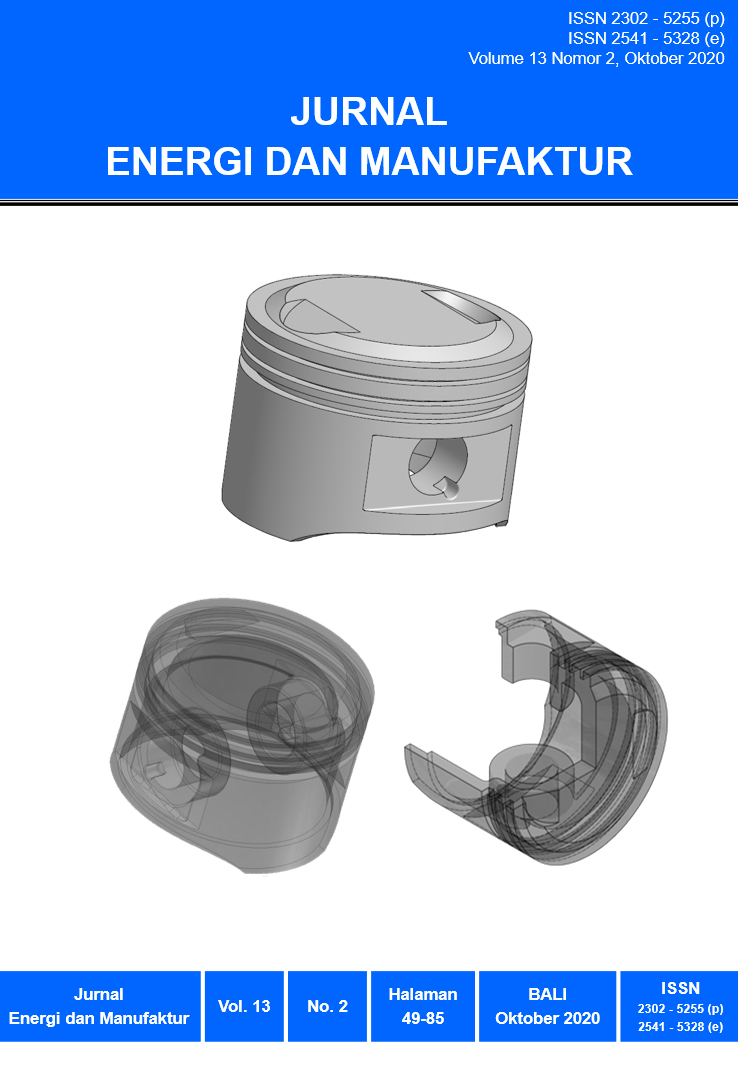Simulasi CFD Pengaruh Konsentrasi Nanofluida Al2O3/Air Terhadap Performa Perpindahan Panas Pipa Radiator
Abstract
The performance of heat transfer on a car radiator can be improved by using nanofluids as working fluids. In this study analyzes the of heat transfer performance of Al2O3/water nanofluids that pass through cylindrical pipes in 3D using the CFD simulation method for single phase approach. This research studied the effect of nanofluid concentration 0.1, 0.5, 1 and 1.5% on the heat transfer coefficient. The Reynolds number is varied between 9000 to 23000 and the ambient temperature is constant. The results showed that 1.5% Al2O3/water nanofluid increasing heat transfer coefficient up to 5.7% compared to base fluid.
Downloads
References
[2] S. T. J. Zainal S., Tan C., Sian C.J., “ANSYS simulation for Ag / HEG Hybrid Nanofluid in Turbulent Circular Pipe,” J. Adv. Res. Appl. Mech., vol. 23, no. 1, pp. 20–35, 2016.
[3] O. Mahian et al., “Recent advances in modeling and simulation of nanofluid flows-Part I: Fundamental and theory,” Phys. Rep., 2018.
[4] S. U. S. Choi, “Enhancing thermal conductivity of fluids with nanoparticles,” Am. Soc. Mech. Eng. Fluids Eng. Div. FED, vol. 231, no. March, pp. 99–105, 1995.
[5] S. M. Peyghambarzadeh, S. H. Hashemabadi, M. S. Jamnani, and S. M. Hoseini, “Improving the cooling performance of automobile radiator with Al 2O3/water nanofluid,” Appl. Therm. Eng., vol. 31, no. 10, pp. 1833–1838, 2011.
[6] M. Naraki, S. M. Peyghambarzadeh, S. H. Hashemabadi, and Y. Vermahmoudi, “Parametric study of overall heat transfer coefficient of CuO/water nanofluids in a car radiator,” Int. J. Therm. Sci., vol. 66, pp. 82–90, 2013.
[7] S. M. Peyghambarzadeh, S. H. Hashemabadi, M. Naraki, and Y. Vermahmoudi, “Experimental study of overall heat transfer coefficient in the application of dilute nanofluids in the car radiator,” Appl. Therm. Eng., vol. 52, no. 1, pp. 8–16, 2013.
[8] M. Akbari, N. Galanis, and A. Behzadmehr, “Comparative analysis of single and two-phase models for CFD studies of nanofluid heat transfer,” Int. J. Therm. Sci., vol. 50, no. 8, pp. 1343–1354, 2011.
[9] V. Delavari and S. H. Hashemabadi, “CFD simulation of heat transfer enhancement of Al 2 O 3 / water and Al 2 O 3 / ethylene glycol nano fl uids in a car radiator,” Appl. Therm. Eng., vol. 73, no. 1, pp. 378–388, 2014.
[10] X. Wang and A. S. Mujumdar, “A REVIEW ON NANOFLUIDS - PART I : THEORETICAL AND NUMERICAL INVESTIGATIONS,” vol. 25, no. 04, pp. 613–630, 2008.
[11] O. Mahian et al., “Recent advances in modeling and simulation of nanofluid flows-part II: Applications,” Phys. Rep., 2018.
[12] H. C. Brinkman, “The Viscosity of Concentrated Suspensions and Solutions,” vol. 571, pp. 1–2, 1952.
[13] F. P. D. P. D. Theodore L. Bergman, Adrienne S. Levine, Incropera, Intoduction To Heat Transfer, Edition, S. 2011.
[14] M. Ataei and F. S. Moghanlou, “Heat transfer and flow characteristics of hybrid Al 2 O 3 / TiO 2 – water nanofluid in a minichannel heat sink,” 2020.
[15] Z. Said et al., “Enhancing the performance of automotive radiators using nano fl uids,” Renew. Sustain. Energy Rev., vol. 112, no. May, pp. 183–194, 2019.
[16] H. Togun, H. I. Abu-mulaweh, S. N. Kazi, and A. Badarudin, “Numerical simulation of heat transfer and separation Al 2 O 3 / nano fl uid fl ow in concentric annular pipe ☆,” vol. 71, pp. 108–117, 2016.

This work is licensed under a Creative Commons Attribution-NonCommercial-ShareAlike 4.0 International License.









